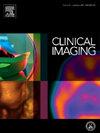Multimodal approach to optimize biopsy decision-making for PI-RADS 3 lesions on multiparametric MRI
IF 1.5
4区 医学
Q3 RADIOLOGY, NUCLEAR MEDICINE & MEDICAL IMAGING
引用次数: 0
Abstract
Purpose
To develop and evaluate a multimodal approach including clinical parameters and biparametric MRI-based artificial intelligence (AI) model for determining the necessity of prostate biopsy in patients with PI-RADS 3 lesions.
Methods
This retrospective study included a prospectively recruited patient cohort with PI-RADS 3 lesions who underwent prostate MRI and MRI/US fusion-guided biopsy between April 2019 and February 2024 in a single institution. The study examined demographic data, PSA and PSA density (PSAD) levels, prostate volumes, prospective PI-RADS v2.1-compliant interpretations of a genitourinary radiologist, lesion characteristics, history of prior biopsies, and AI evaluations, focusing mainly on the detection of clinically significant prostate cancer (csPCa) (International Society of Urological Pathology grade group ≥2) on MRI/US fusion-guided biopsy. The AI model lesion segmentations were compared to manual segmentations and biopsy results. The statistical methods employed included Fisher's exact test and logistic regression.
Results
The cohort was comprised of 248 patients with 312 PI-RADS 3 lesions in total (n = 268 non-csPCa, n = 44 csPCa). The AI model's negative predictive value (NPV) was 89.2 % for csPCa in all lesions. In patient-level analysis, the NPV was 91.2 % for patients with a highest PI-RADS score of 3. PSAD was a significant predictor of csPCa (odds ratio = 5.8, p = 0.038). Combining AI and PSAD, where AI correctly mapped a lesion or PSAD ≥0.15 ng/mL2, achieved higher sensitivity (77.8 %) while maintaining a high NPV (93.1 %).
Conclusion
Combining AI and PSAD has the potential to enhance biopsy decision-making for PI-RADS 3 lesions by minimizing missed csPCa occurrences and reducing unnecessary biopsies.
多模态方法优化多参数磁共振成像上 PI-RADS 3 病变的活检决策。
目的:开发和评估一种多模态方法,包括临床参数和基于双参数 MRI 的人工智能(AI)模型,用于确定 PI-RADS 3 病变患者进行前列腺活检的必要性:这项回顾性研究纳入了前瞻性招募的PI-RADS 3病变患者队列,这些患者在2019年4月至2024年2月期间在一家机构接受了前列腺MRI和MRI/US融合引导下的活检。该研究检查了人口统计学数据、PSA和PSA密度(PSAD)水平、前列腺体积、泌尿生殖系统放射科医生符合PI-RADS v2.1标准的前瞻性解释、病变特征、既往活检史和AI评估,主要侧重于在MRI/US融合引导活检中发现有临床意义的前列腺癌(csPCa)(国际泌尿病理学会分级组≥2)。人工智能模型病灶分割与人工分割和活检结果进行了比较。采用的统计方法包括费雪精确检验和逻辑回归:结果:研究组由 248 名患者组成,共有 312 个 PI-RADS 3 病灶(n = 268 个非 csPCa,n = 44 个 csPCa)。在所有病变中,AI 模型对 csPCa 的阴性预测值 (NPV) 为 89.2%。在患者层面的分析中,PI-RADS 最高评分为 3 分的患者的阴性预测值为 91.2%。PSAD 是 csPCa 的重要预测因子(几率比 = 5.8,p = 0.038)。结合 AI 和 PSAD,当 AI 正确映射出病变或 PSAD ≥0.15 ng/mL2 时,可获得更高的灵敏度(77.8%),同时保持较高的 NPV(93.1%):结论:将 AI 和 PSAD 结合使用可最大限度地减少漏诊 csPCa 并减少不必要的活检,从而提高 PI-RADS 3 病变的活检决策水平。
本文章由计算机程序翻译,如有差异,请以英文原文为准。
求助全文
约1分钟内获得全文
求助全文
来源期刊

Clinical Imaging
医学-核医学
CiteScore
4.60
自引率
0.00%
发文量
265
审稿时长
35 days
期刊介绍:
The mission of Clinical Imaging is to publish, in a timely manner, the very best radiology research from the United States and around the world with special attention to the impact of medical imaging on patient care. The journal''s publications cover all imaging modalities, radiology issues related to patients, policy and practice improvements, and clinically-oriented imaging physics and informatics. The journal is a valuable resource for practicing radiologists, radiologists-in-training and other clinicians with an interest in imaging. Papers are carefully peer-reviewed and selected by our experienced subject editors who are leading experts spanning the range of imaging sub-specialties, which include:
-Body Imaging-
Breast Imaging-
Cardiothoracic Imaging-
Imaging Physics and Informatics-
Molecular Imaging and Nuclear Medicine-
Musculoskeletal and Emergency Imaging-
Neuroradiology-
Practice, Policy & Education-
Pediatric Imaging-
Vascular and Interventional Radiology
 求助内容:
求助内容: 应助结果提醒方式:
应助结果提醒方式:


